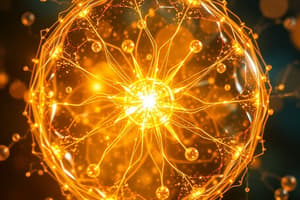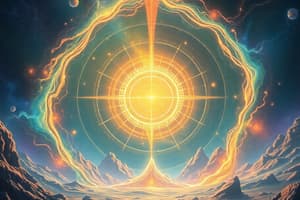Podcast
Questions and Answers
What is the primary structural feature of glycogen?
What is the primary structural feature of glycogen?
- Linear chain only
- Unbranched with a central protein
- Completely symmetrical
- Branched-chain (correct)
The liver only uses glycogen for its own energy needs.
The liver only uses glycogen for its own energy needs.
False (B)
What molecule needs to be activated by UDP before being integrated into glycogen?
What molecule needs to be activated by UDP before being integrated into glycogen?
Glucose 1-P
The synthesis of ribose 5-phosphate is a product of the __________ pathway.
The synthesis of ribose 5-phosphate is a product of the __________ pathway.
Which of the following is a function of glycogen in skeletal muscle?
Which of the following is a function of glycogen in skeletal muscle?
Match the following components with their associated functions:
Match the following components with their associated functions:
Which type of reaction in the Pentose Phosphate Pathway is irreversible?
Which type of reaction in the Pentose Phosphate Pathway is irreversible?
What is the center protein around which glycogen is built?
What is the center protein around which glycogen is built?
What is the primary function of NADH and FADH2 in the electron transport chain?
What is the primary function of NADH and FADH2 in the electron transport chain?
One molecule of NADH yields approximately 2.5 ATP when fully oxidized.
One molecule of NADH yields approximately 2.5 ATP when fully oxidized.
What is the total ATP yield from one mole of glucose after glycolysis and the TCA cycle?
What is the total ATP yield from one mole of glucose after glycolysis and the TCA cycle?
The conversion of pyruvate to acetyl-CoA occurs during the ______ stage.
The conversion of pyruvate to acetyl-CoA occurs during the ______ stage.
Match the following pathways with their descriptions:
Match the following pathways with their descriptions:
Which shuttle converts NADH into FADH2 within the mitochondria?
Which shuttle converts NADH into FADH2 within the mitochondria?
The body relies solely on dietary intake for a stable blood glucose level.
The body relies solely on dietary intake for a stable blood glucose level.
Name one of the end products of glycolysis.
Name one of the end products of glycolysis.
After glycolysis, pyruvate is converted to ______ before entering the TCA cycle.
After glycolysis, pyruvate is converted to ______ before entering the TCA cycle.
From where can blood glucose be obtained?
From where can blood glucose be obtained?
What is the main purpose of bioenergetics?
What is the main purpose of bioenergetics?
A negative ΔG indicates a spontaneous reaction.
A negative ΔG indicates a spontaneous reaction.
What are the two main types of ATP production?
What are the two main types of ATP production?
The __________ cycle is also known as the Krebs cycle.
The __________ cycle is also known as the Krebs cycle.
Match the following metabolic pathways with their functions:
Match the following metabolic pathways with their functions:
Which molecule is commonly referred to as the energy currency of the cell?
Which molecule is commonly referred to as the energy currency of the cell?
The electron transport chain involves the reduction of oxygen to water.
The electron transport chain involves the reduction of oxygen to water.
What is the end product of glycolysis?
What is the end product of glycolysis?
NADH and FADH2 serve as electron __________ in ATP synthesis.
NADH and FADH2 serve as electron __________ in ATP synthesis.
Match the following ATP production methods with their descriptions:
Match the following ATP production methods with their descriptions:
Which pathway provides intermediates for the synthesis of amino acids, lipids, and carbohydrates?
Which pathway provides intermediates for the synthesis of amino acids, lipids, and carbohydrates?
Glycogenesis is the process of breaking down glycogen into glucose.
Glycogenesis is the process of breaking down glycogen into glucose.
What happens to pyruvate in the presence of oxygen?
What happens to pyruvate in the presence of oxygen?
The __________ phosphate pathway produces ribose-5-phosphate.
The __________ phosphate pathway produces ribose-5-phosphate.
Match each molecule with its energy contribution:
Match each molecule with its energy contribution:
Flashcards
Cellular Respiration
Cellular Respiration
The process by which the cell generates energy by oxidizing glucose, leading to the production of ATP.
ATP (Adenosine Triphosphate)
ATP (Adenosine Triphosphate)
A high-energy molecule that provides energy for most cellular processes.
Electron Transport Chain (ETC)
Electron Transport Chain (ETC)
A series of protein complexes embedded in the inner mitochondrial membrane that transfers electrons to create a proton gradient, driving ATP synthesis.
Oxidative Phosphorylation
Oxidative Phosphorylation
Signup and view all the flashcards
Glycolysis
Glycolysis
Signup and view all the flashcards
Krebs Cycle (Citric Acid Cycle)
Krebs Cycle (Citric Acid Cycle)
Signup and view all the flashcards
Malate-Aspartate Shuttle
Malate-Aspartate Shuttle
Signup and view all the flashcards
Glycerol 3-Phosphate Shuttle
Glycerol 3-Phosphate Shuttle
Signup and view all the flashcards
Glycogen
Glycogen
Signup and view all the flashcards
Gluconeogenesis
Gluconeogenesis
Signup and view all the flashcards
Glycogen Structure
Glycogen Structure
Signup and view all the flashcards
Glycogen in Muscle
Glycogen in Muscle
Signup and view all the flashcards
Glycogen in Liver
Glycogen in Liver
Signup and view all the flashcards
Glycogen Synthesis
Glycogen Synthesis
Signup and view all the flashcards
Glycogen Degradation
Glycogen Degradation
Signup and view all the flashcards
Pentose Phosphate Pathway
Pentose Phosphate Pathway
Signup and view all the flashcards
Bioenergetics
Bioenergetics
Signup and view all the flashcards
Gibbs Free Energy Change (ΔG)
Gibbs Free Energy Change (ΔG)
Signup and view all the flashcards
Exergonic reaction
Exergonic reaction
Signup and view all the flashcards
Endergonic reaction
Endergonic reaction
Signup and view all the flashcards
Substrate-level phosphorylation
Substrate-level phosphorylation
Signup and view all the flashcards
Pentose Phosphate Pathway (PPP)
Pentose Phosphate Pathway (PPP)
Signup and view all the flashcards
Glycogenolysis
Glycogenolysis
Signup and view all the flashcards
Glycogenesis
Glycogenesis
Signup and view all the flashcards
Citric Acid Cycle (TCA Cycle)
Citric Acid Cycle (TCA Cycle)
Signup and view all the flashcards
Electron carrier
Electron carrier
Signup and view all the flashcards
Study Notes
Bioenergetics
- Bioenergetics is the transfer and utilization of energy in biological systems
- Bioenergetics predicts if a process is possible, while kinetics measures the reaction rate
- Enzymes cannot initiate a chemical reaction on their own
- Molecules and reactions can be either exergonic or endergonic
Free Energy Change (ΔG)
- ΔG = final energy - initial energy
- A negative ΔG indicates a spontaneous reaction (exergonic) that releases energy
- A positive ΔG indicates a nonspontaneous reaction (endergonic) that requires energy input
ATP Production
- ATP is the primary energy currency for cells
- Substrate-level phosphorylation
- Oxidative phosphorylation
Carbohydrate Metabolism
- Glucose is a critical energy source
- Glycolysis, glycogenolysis, and gluconeogenesis are key pathways for glucose metabolism
- Glycogen is used for glucose storage
Hormonal Regulation of Glycolysis
- Hormones, like insulin and glucagon, regulate glucose uptake and utilization
- Insulin typically increases glycolysis, while glucagon likely decreases it
Glycolysis - NAD+ Regeneration
- Glycolysis requires NAD+ to occur
- Fermentation produces NAD+ when oxygen is absent
TCA Cycle
- The TCA cycle is crucial to capture high-energy electrons
- The cycle's purpose is to harvest high-energy electrons from carbon fuels
- Electrons are captured as NADH and FADH2 for ATP production
Oxidative Phosphorylation and ETC
- The electron transport chain (ETC) is involved with oxidative phosphorylation
- NADH and FADH2 carry high-energy electrons, resulting in ATP production
Electron Transport Chain
- Electrons carried by NADH and FADH2 are captured by the system
- Oxygen is reduced to water
- ETC complexes pump H+ to outer membranes
- Positive charge out of the membrane produces a flow into the matrix
- ATP is synthesised
ETC - Overall Picture
- NADH enters from Complex I, FADH2 from Complex II
- One NADH pumps three protons
- One FADH2 pumps two protons
Energy Gained from 1 mol Glucose
- Glycolysis produces 2 ATP and 2 NADH
- Pyruvate yields 2 NADH in the cytoplasm
- Acetyl-CoA yields 6 NADH and 2 FADH2
- The total number of ATPs produced from a mol of glucose depends on the shuttle systems used to transport NADH from the cytoplasm to the mitochondria
Transfer of Cytoplasmic NADH to Mitochondria
- Malate Aspartate Shuttle and Glycerol 3-phosphate shuttle are used to transport NADH into the mitochondrial
- NADH can't enter the mitochondria directly
Pentose Phosphate Pathway
- It produces NADPH and ribose 5-phosphate
- The pathway has oxidative and non-oxidative reactions
- Ribose 5-phosphate is used in nucleotide synthesis.
Glycogen
- A storage form of glucose in animals
- Glycogen is predominantly stored in the liver and muscle
- Glycogen degradation serves as a critical energy source
- The synthesis involves glucose 1-P activation with UDP
- Glycogen degradation occurs by cleaving glucose molecules
Studying That Suits You
Use AI to generate personalized quizzes and flashcards to suit your learning preferences.




